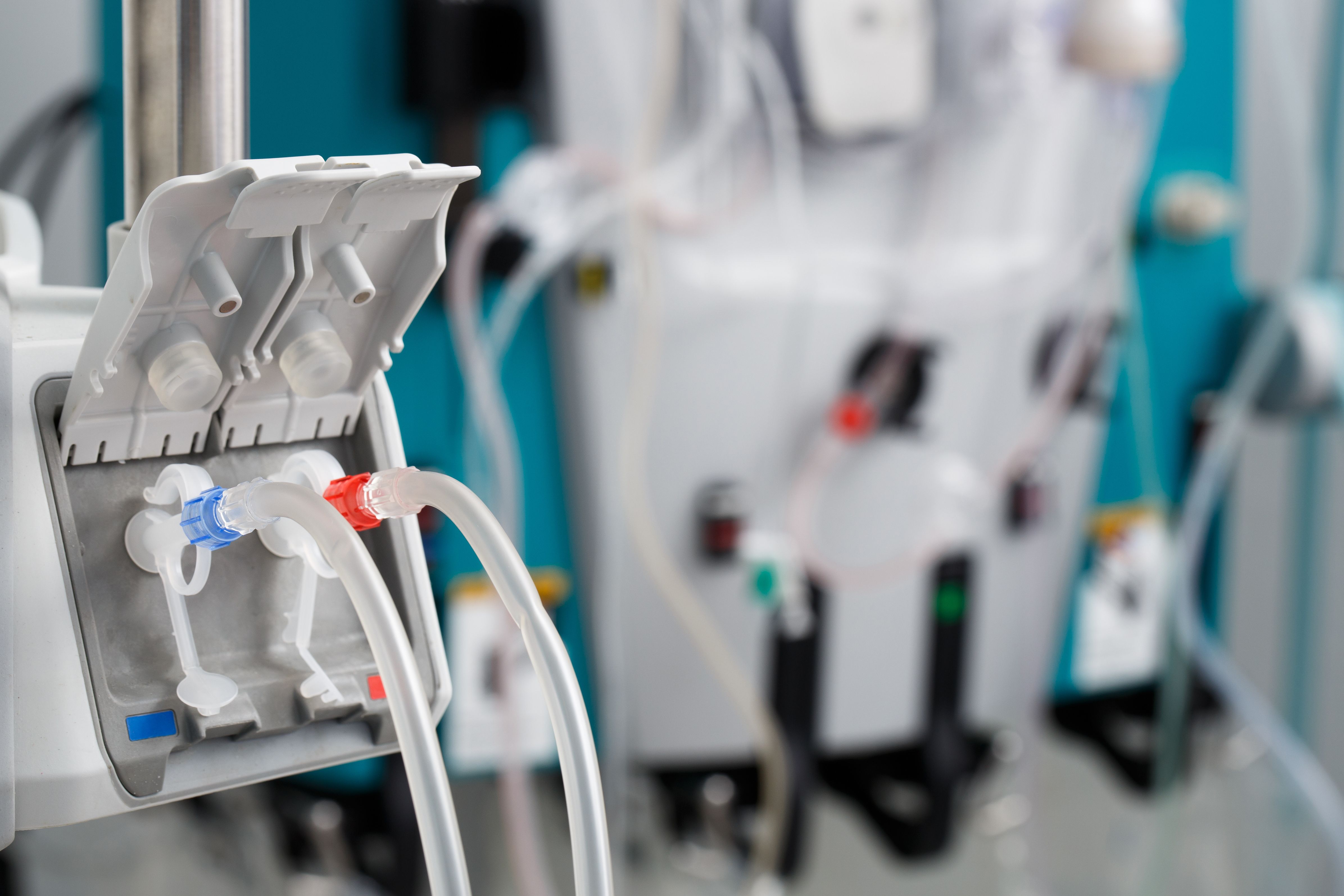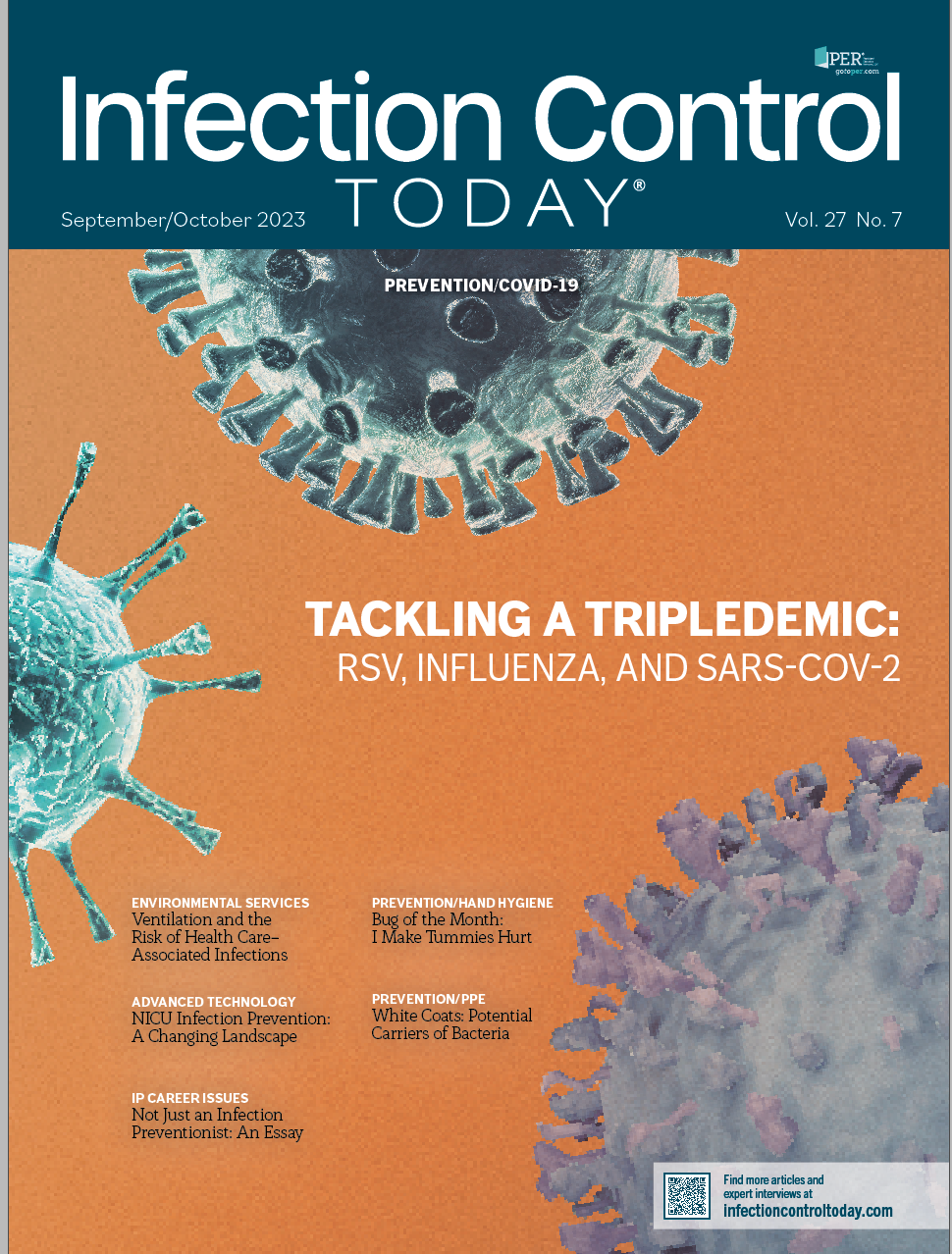How to Prevent Risk of Vascular Access-Related Blood Stream Infections in Patients Undergoing Hemodialysis
Staphylococcal organisms, which have high mortality rates and can cause recurrence and metastatic complications, are responsible for a significant proportion of infections related to vascular access.
Hemodialysis bloodline tubes in dialysis machine. © zlikovec- stock.adobe.com

Vascular access-related infection is a second major cause of mortality among end-stage renal disease patients undergoing hemodialysis (HD). Dialysis patients require vascular access to deliver their renal failure treatment. Commonly used vascular accesses are arteriovenous fistula (AVF), arteriovenous graft (AVG), and central lines.1,2 Vascular access-related infection is highest when central venous dialysis catheters are employed. Native arteriovenous fistulas carry the lowest risk of infection.1 Unfortunately, prosthetic arteriovenous grafts, which represent the most common type of HD access in the United States, have been repeatedly shown to be a risk factor for bacteremic and nonbacteremic infections. High proportions of infections related to vascular access are caused by staphylococcal organisms, which carry high mortality rates, recurrence, and metastatic complications.1,2
Several studies have attempted to define catheter-related bacteremia (CRB) risk factors.1 Both the insertion site and the use duration influence the infection rate. Femoral catheters are more susceptible to infections than thoracic catheters. This may relate to the accumulation of sweat and moisture around the exit site. The type of catheter and site of insertion significantly impact the involvement of catheter-related infections, such as tunneled and cuffed catheters, are considered as a low incidence of bacteremia compared to non-tunneled catheters.2 Similarly, temporary HD catheters placed in the internal jugular vein are associated with higher infection rates than those placed in the subclavian vein.2
However, these outcomes should not justify the routine use of subclavian veins for HD catheters for 2 reasons. First, these findings may not apply to tunneled catheters. Second, the subclavian location carries the highest rate of catheter-associated central venous stenosis. The duration of catheter use is also essential as the risk of infection increases linearly with time.2,3
Nurses, medical providers, dialysis technicians, and others who work in dialysis facilities face the difficult task of managing the complex circumstances affecting their patients while concurrently focusing on reducing the risk of infection for these at-risk individuals. CDC’s core interventions have been proven to reduce dialysis bloodstream infections and can help to improve the quality of vascular access in dialysis patients.4
Staff Education and Training
Educating health care providers regarding the appropriate need and use of intravascular catheters and the proper insertion techniques can significantly reduce the risk of vascular infections in dialysis patients. Periodic competency assessment and appropriate staffing ratio is another supportive intervention in preventing infections.
Selection of Vascular Access
The use of fistula and graft in chronic kidney disease patients for their dialysis treatment is highly recommended.1,2,4 Subclavian sites in dialysis and chronic kidney disease patients should be avoided as much as possible to prevent the long-term complication of central venous stenosis. Avoiding using femoral sites for central line insertion in adult patients also significantly reduces bloodstream infections.
Use of Aseptic Technique
Performing hand hygiene procedures and following strict aseptic measures are core considerations in preventing vascular access-related infections. Wearing either clean or sterile gloves when changing dressings on central lines is acceptable; however, to ensure maximal barrier precautions, cap, sterile gloves, sterile gown, and sterile full body drape are highly recommended during the insertion of central lines.
Antibiotic Lock Prophylaxis
Using prophylactic antimicrobial lock solution in patients with long-term catheters who have a history of multiple catheter-related bloodstream infections (CRBSI) despite optimal maximal adherence to aseptic technique is a recognized approach to reduce the incidence of BSI among dialysis patients.4,5
Patient Education and Engagement
Provision of standardized education to all patients on infection prevention topics, including vascular access care, hand hygiene, risks related to catheter use, recognizing signs of infection, and instructions for access management when away from the dialysis unit is one of the highly impactful preventive measures. Patients with fistulas should be instructed to wash their access site with soap and water before cannulation during each dialysis session. Patients dialyzed through central lines need to be instructed not to change their dressings at home. Also, they should avoid merging the catheter insertion sites in water. Prompt reporting of local site infections around vascular access, such as pus, increased swelling, and redness, is required.
Catheter Skin Preparation
According to CDC, >0.5% chlorhexidine preparation with alcohol before central venous catheter insertion and during maintenance care is advisable. If there is a contraindication to chlorhexidine, a tincture of iodine, an iodophor, or 70% alcohol can be used as alternatives.4
Reduction
One of the highly effective core interventions is to reduce the number of central lines in dialysis patients. Early initiation of fistulas is highly recommended during stages 4 and 5 of end-stage renal disease. Incorporate efforts (eg through patient education, vascular access coordinator) to reduce catheters by identifying and addressing barriers to permanent vascular access placement and catheter removal.6,7,8,9
Surveillance and Feedback Using NHSN
Conducting monthly surveillance for BSIs and other dialysis events using the National Healthcare Safety Network (NHSN)—Dialysis Surveillance.6 Calculating facility rates and comparing them with other NHSN facilities. Actively sharing results with front-line clinical staff is a highly effective strategy to ensure maximum staff compliance to reduce vascular access infections in dialysis patients. Another source is CDC audit tools and checklists for BSI prevention in dialysis patients.4
References
1. Gulati S, Sahu KM, Avula S, Sharma RK, Ayyagiri A, Pandey CM. Role of vascular access as a risk factor for infections in hemodialysis. Ren Fail. 2003;25(6):967-973. doi:10.1081/JDI-120026031
2. Nassar GM, Ayus JC. Infectious complications of hemodialysis access. Kidney Int. 2001;60(1):1-13. doi:10.1046/j.1523-1755.2001.00765.x
3. Kairaitis LK, Gottlieb T. Outcome and complications of temporary haemodialysis catheters. Nephrol Dial Transplant. 1999;14(7):1710-1714. doi:10.1093/ndt/14.7.1710
4. Dialysis component. Centers for Disease Control and Prevention. March 30, 2023. Accessed August 22, 2023.
5. Summary of recommendations. Centers for Disease Control and Prevention. February 2017. Accessed August 22, 2023. https://www.cdc.gov/infectioncontrol/guidelines/bsi/recommendations.html
6. Audit Tools and Checklists. Centers for Disease Control and Prevention. January 11, 2023. Accessed August 22, 2023.
7. Shahar S, Mustafar R, Kamaruzaman L, Periyasamy P, Pau KB, Ramli R. Catheter-related bloodstream infections and catheter colonization among haemodialysis patients: prevalence, risk factors, and outcomes. Int J Nephrol. 2021:5562690. doi:10.1155/2021/5562690
8. Kumbar L, Yee J. Current concepts in hemodialysis vascular access infections. Adv Chronic Kidney Dis. 2019;26(1):16-22. doi:10.1053/j.ackd.2018.10.005
9. Health Services Advisory Group. Reducing dialysis related infections and hospitalizations. Susan Moretti. End-stage renal disease network 15. September 19, 2018. Accessed August 22, 2023. https://health.wyo.gov/wp-content/uploads/2018/09/Moretti-ReduceDialysisRelatedInfHos508.pdf

Show, Tell, Teach: Elevating EVS Training Through Cognitive Science and Performance Coaching
April 25th 2025Training EVS workers for hygiene excellence demands more than manuals—it requires active engagement, motor skills coaching, and teach-back techniques to reduce HAIs and improve patient outcomes.
The Rise of Disposable Products in Health Care Cleaning and Linens
April 25th 2025Health care-associated infections are driving a shift toward disposable microfiber cloths, mop pads, and curtains—offering infection prevention, regulatory compliance, and operational efficiency in one-time-use solutions.
Phage Therapy’s Future: Tackling Antimicrobial Resistance With Precision Viruses
April 24th 2025Bacteriophage therapy presents a promising alternative to antibiotics, especially as antimicrobial resistance continues to increase. Dr. Ran Nir-Paz discusses its potential, challenges, and future applications in this technology.
Show, Tell, Teach: Elevating EVS Training Through Cognitive Science and Performance Coaching
April 25th 2025Training EVS workers for hygiene excellence demands more than manuals—it requires active engagement, motor skills coaching, and teach-back techniques to reduce HAIs and improve patient outcomes.
The Rise of Disposable Products in Health Care Cleaning and Linens
April 25th 2025Health care-associated infections are driving a shift toward disposable microfiber cloths, mop pads, and curtains—offering infection prevention, regulatory compliance, and operational efficiency in one-time-use solutions.
Phage Therapy’s Future: Tackling Antimicrobial Resistance With Precision Viruses
April 24th 2025Bacteriophage therapy presents a promising alternative to antibiotics, especially as antimicrobial resistance continues to increase. Dr. Ran Nir-Paz discusses its potential, challenges, and future applications in this technology.
2 Commerce Drive
Cranbury, NJ 08512